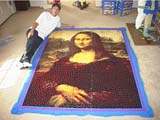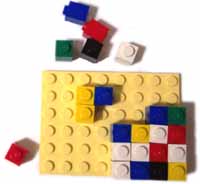LEGO Mosaics
 This page should serve as an introduction to the concept of LEGO Mosaics. It is intended for people who potentially wish to purchase/commission such an item. The terms and concepts explained herein will help the individual better understand the different types of mosaics, and better decide what type of mosaic best suits his or her needs.
This page should serve as an introduction to the concept of LEGO Mosaics. It is intended for people who potentially wish to purchase/commission such an item. The terms and concepts explained herein will help the individual better understand the different types of mosaics, and better decide what type of mosaic best suits his or her needs.
Mosaics serve as an alternative to LEGO Sculptures (which I also build). While both are equally impressive in final form, mosaics have a number advantages as far as practicality. They are easier to design and build, easier to estimate cost, and easier to ship than sculptures. All of these factors mean they can be built with less expense for the client.
Mosaics are designed and crafted using proprietary software programmed for just this purpose. The client need only send me a digital picture (either .GIF or .JPG format). It can be in color or black and white depending on the desired look of the final mosaic (more on that below). Usually the picture need not be too large in filesize; 50K bytes at most.
There are four major things to consider when thinking about a LEGO Mosaic: size, color, orientation, and cost (which is very much related to the first three).
Size
Generally a LEGO mosaic is measured in terms of its width in 'studs'. A standard LEGO brick, of course, has a number of studs (bumps, pegs, etc) on top of it. The smallest standard brick is a 1x1 which has, simply, one stud atop it. In terms of inches, a 1x1 brick is 5/16" wide, so this may be used as a conversion factor: every stud is 5/16ths of an inch (e.g. a mosaic that is 144 studs wide is exactly 45 inches wide).The height of a mosaic will pretty much be determined by the original digital image analysed. The proportions of the final mosaic will be the same as whatever image I run through the computer program.
Obviously, the larger a mosaic is made, the more detail that can be acheived in the image that is built. LEGO mosaics are analogous to pixels on a computer screen... the more area you have to work with, the better the detail. Of course, a large mosaic will not only weigh more, it will also take longer to build, and its final cost will be more.
Color
 A couple of choices here, really. A mosaic can be in color or grayscale. Most people would think that color would be neatest, but this is not always the case. LEGO colors are, of course, very bright (almost garish). So bright, in fact, that they do not always lend themselves well to a mosaic. There is little subtlety between colors, so when one is dealing with some pictures that have gentle gradations of color, the overly saturated LEGO bricks do not always work well.
A couple of choices here, really. A mosaic can be in color or grayscale. Most people would think that color would be neatest, but this is not always the case. LEGO colors are, of course, very bright (almost garish). So bright, in fact, that they do not always lend themselves well to a mosaic. There is little subtlety between colors, so when one is dealing with some pictures that have gentle gradations of color, the overly saturated LEGO bricks do not always work well.
Grayscale mosaics, on the other hand, do often work better. There are 5 brick colors available for grayscale mosaics: black, white, and three shades of gray. This relative abundance provides a fair amount of choice, and pictures (say, a black and white photograph) benefit greatly from this range.
This is not to say that color mosaics cannot be done or are only to be used on images of cartoons or such (images with simple swaths of vivid colors). It's just that in order for the bright LEGO colors to visually 'bleed' into one another appropriately, the mosaic often has to be quite large (check out the Mona Lisa mosaic as an example -- it is quite large).
Examples of grayscale mosaics can be found here: New York Skyline, Mr. Fandango.
Orientation
This refers to the orientation of the bricks as they are used to build the mosaic. There are two main choices here: 'Studs Out' and 'Studs Up'. Each name refers to the orientation of the individual bricks assuming the mosaic is hung on a wall and an individual is looking at the picture.Studs Out
This describes a mosaic in which the brick studs point out toward the user when the mosaic is hung on a wall. These mosaic are built with large LEGO baseplate pieces forming a backing to the picture, and a single layer of bricks covers those baseplates. When hung, the baseplates are behind (against the wall) and not visible to the viewer; all he or she sees is the image formed by the bricks.
 With the studs pointing toward the viewer, there is a definite 'LEGO-ness' about the mosaic. A viewer can see (and touch) the bumpy studs of the mosaic.
With the studs pointing toward the viewer, there is a definite 'LEGO-ness' about the mosaic. A viewer can see (and touch) the bumpy studs of the mosaic.
Since the viewer is actually looking down upon the top of the individual bricks, this means that each unit brick provides a perfect square pixel to the mosaic. This allows one to think of the bricks as 'physical pixels'... each an exact square of a particular color... many such squares being used to form a complete picture.
Since the bricks are placed on baseplates, and LEGO baseplates come in two standard sizes (32 studs and 48 studs, 10" and 15" respectively), most Studs Out mosaics are build so that there dimensions are some multiple of those numbers (e.g. 20"x20" or 30"x45").
An advantage to this type of orientation is that for shipment the mosaic can usually be broken down into its baseplate sections and shipped in a relatively small container (for example, this 10' square potrait mosaic of Dean Cain was broken down and shipped in two small boxes: 16" cubes). Of course, this mode of shipment requires reassembly on the receiving end.
The cost of Studs Out mosaics is usually less than that of Studs Up because the whole thing can be done with standard bricks (as opposed to also using 1/3 height LEGO plates). Also, glue is rarely needed with Studs Out mosaics, so time and labor fees associated with gluing are saved as well.
Studs Up
This describes a mosaic in which the bricks are stacked atop one another in what is considered the typical LEGO fashion. With brick on top of brick when the mosaic is hung, the viewer is actually looking at the sides of the bricks and the only studs visible are along the top edge. The studs point upward.Since LEGO makes pieces which are 1/3 the height of the standard brick (these shorter pieces are known as 'plates'), this type of mosaic can take advantage of that fact. Looking at the side of the pieces, the plates may be used to obtain a finer 'resolution' of the overall picture... finer than one could obtain using just bricks, or using a Studs Out orientation.
Since one is viewing the bricks and plates from the side, the smallest units in the mosaic are not square. From the side a standard brick has a height:width ratio of 6:5, and a plate is 2:5 (1/3 the height). So while the overall resolution is increased, the 'squareness' of each unit piece is lost.
For Studs Up mosaics of any significant size, gluing is usually necessary to hold all of the pieces together. This will increase the time needed to build as well as increase the overall cost of the piece.
Experimental Mosaics
I am constantly building new types of models and mosaics; if a client has an idea he or she would like to suggest, it is welcome. One example of an extraordinary mosaic is the Calista mosaic which, while technically just a Studs Out mosaic, employs smaller than usual bricks and takes advantage of letters printed on those bricks.All of that being stated, here is a summary and comparison of the types of orientations.
| Studs Out | Studs Up | Other | |
| Tactile Quality | Bumpy to touch | Smooth to touch | Varies |
| Resolution | Good (square) (but square pixels) | Better (non-square) (but non-square pixels) | Varies |
| Shipping/Hanging | Easier (shipped in sections) | Harder (shipped as one large mosaic) | Varies |
| Glue Required | No | Yes, usually | Varies |
| Cost | Less | More | Varies |
| Examples |
White Rabbit
Mona Lego New York City San Francisco Suicide King Samford Hall |
Mr. Fandango
Tree Frog Mona Lisa, redux Girl With A Pearl Earring |
Pegasus (Relief)
a & a productions Logo (Studs Up/Relief) Auburn University Logo (Studs Left/Relief) Mad Hatter (Studs-Not-On-Top) |
Cost
The overall cost of a mosaic is based on all of those factors above. Piece availability, deadlines, and such can also affect the cost. Each commission is negotiated on an individual basis.LEGO® and related marks are trademarks or registered trademarks of The LEGO Company, which does not sponsor, authorize, nor endorse this site. All photographs and text on this website are © Copyright (1999 - 2003) to Eric Harshbarger unless otherwise noted.